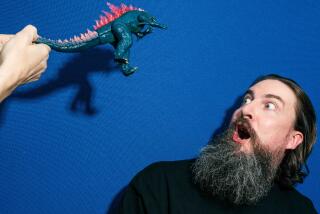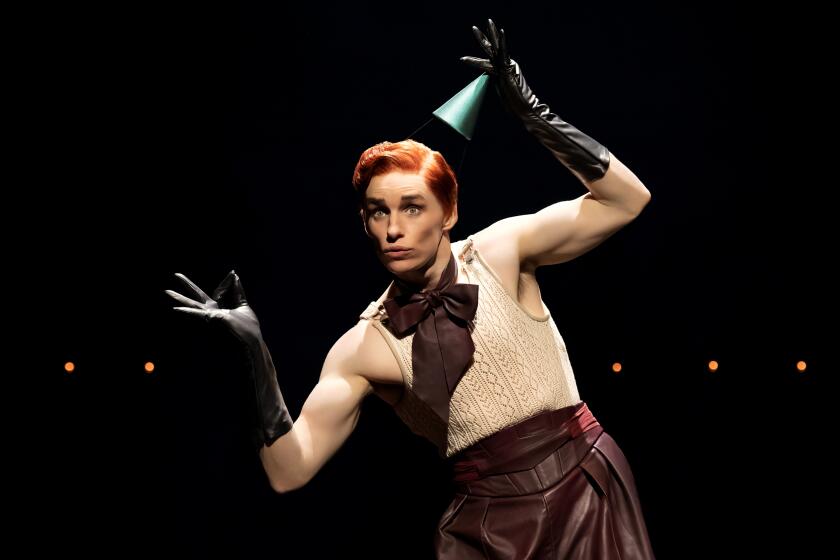Review: ‘King Kong,’ a giant animatronic ape with soulful eyes, crashes down on Broadway
“King Kong,” the stage animal first seen wreaking havoc in Australia, has arrived on Broadway with a seismic thud and a thundering roar.
Just how horrifying is the new show? It has turned a self-respecting drama critic into a screaming Fay Wray.
No, I’m not really afraid of being mauled to death by a giant ape in midtown Manhattan. But I am terrified of the monstrous concoction that has been cooked up in the international laboratory of mercenary producers eager to remake Broadway in the image of Barnum & Bailey.
The best thing about this tourist attraction, which had its official opening Thursday at the Broadway Theatre, is Kong himself. The gargantuan creature (reported to be 20 feet tall and weighing 2,000 pounds) requires an onstage team of furtive handlers in dark hoodies to operate as well as a remote robotics crew.
Unlike “The Lion King” and “War Horse,” two Broadway productions that artfully embraced the handcrafted nature of puppet magic, “King Kong” keeps the visible strings and pulleys in the shadows. Amid a swirling backdrop of dreamlike projections (the lyrical work of scenic designer Peter England), the animatronic figure lumbers about the stage in a multimedia kaleidoscope that blurs the line between cinema and theater.
The special effects are often sensational, but the most arresting aspect of this high-tech, 21st century prehistoric simian is his sensitive eyes. Kong might indulge in a few alpha male pounds on the chest after stomping on an enormous snake that foolishly thought it could take him down. But look into those eyes and you’ll see he’s really fighting back tears.
Displays of brute strength seem to hurt him almost as much as they hurt whatever he is forced to dismember. In a better world, he’d be downing banana trees and slurping coconut cocktails. But it’s a jungle out there. And New York turns out to be 10 times worse than Skull Island, Kong’s natural habitat, where dinosaur-size creatures murderously roam.
Jack Thorne, author of the Tony-winning play “Harry Potter and the Cursed Child,” is billed as the writer of this extravaganza, which is directed and choreographed by Drew McOnie. Thorne follows the basic outline of the 1933 classic movie about a swaggering film director named Carl Denham, who casts Ann Darrow, a beauty down on her luck, as the distressed damsel in the new picture he plans to shoot on a faraway tropical island only rumored to exist.
Thorne’s script provides definitive proof that the arts are not evolutionary. “King Kong” the stage version makes the movie look like an unparalleled work of cinematic genius.
I especially missed the rakish cynicism of the Depression-era film, which offers a bracing self-critique of the capitalist greed driving all forms of showbiz. The Broadway production, clearly in it for the money, isn’t even able to wink at its own exploitative shamelessness.
Changes to the story have been imposed to accommodate a worldview reshaped by post-colonialism and feminism. But the politically correct tweaks raise issues of their own. Thorne ditches the natives for walking vines, offending botanical logic rather than indigenous tribes.
The gender politics are an incoherent mix of the old and the new. Ann (Christiani Pitts) is transformed from a passive victim into an ambitious starlet who still has a heart of gold even though she’s willing to compromise her conscience at every turn for the chance of becoming “Queen of New York.” This is the title of one of the show’s highly derivative musical numbers that could be imported directly into the next “Forbidden Broadway” spoof.
Even when the songs by Eddie Perfect jibe with the story, they rarely make emotional sense. “King Kong” doesn’t simply come up short as a stage translation of a landmark horror film. It actually manages to fit around this failure one of the most ludicrous Broadway musicals in recent memory.
Pitts sings her R&B heart out as Ann Darrow, but Wray’s screaming conveyed more dramatic sense. This new Ann, a former farm girl who knows how to soothe Kong’s wounds with mud, is meant to be genuinely conflicted between her sympathy for Kong and her determination to become famous. But she comes off as a split personality, a ready tool for Carl one minute, Kong’s flirty candy striper the next.
The Razzies are reserved for breathtakingly bad work in movies, but I think an exception should be made this year so that Eric William Morris can be duly acknowledged for his hammy stage portrayal of Carl Denham. If you’ve ever wondered how Lyle Waggoner from “The Carol Burnett Show” might have parodied Carl, Morris unintentionally provides an illuminating facsimile.
Lumpy (Erik Lochtefeld), a kindhearted oaf who becomes Ann’s ally on and off the ship, is more or less a simpering figure given a sorrowful backstory. His stooped, superfluous presence only made me miss all the more Jack Driscoll, the hard-boiled first mate memorably played by Bruce Cabot in the original film, who not only got to rescue Wray’s Ann but was somehow able to immortalize one of the most unromantic lines in movie history: “Ann, uh, I uh. Uh. Say, I guess I love you.”
Kong serves as Ann’s main love interest in this stage travesty. The affection never really gets creepy (the producers desperately want to appeal to all markets), but the relationship does get a little weird, not to say logistically challenging. As the intimacy between the mismatched characters grows more tender, the hoodie squad is forced to get acrobatic.
The human-animal bond is the source of whatever genuine feeling the show generates. When Kong is captured and brought back for exhibition in New York, the sight of this great doomed beast is painful to watch.
Kong, raising terror atop the Empire State Building, is too much a victim to truly frighten us. The score by Marius De Vries, the sound design by Peter Hylenski and the lighting by Peter Mumford keep the atmosphere tensely frenetic. But I mostly giggled when Kong moves to the lip of the stage and drops his massive hands treacherously close to nearby audience members, who seemed thrilled to be finally getting their money’s worth.
For whom is this “King Kong” intended? Theatergoers with deep pockets who adore elaborate spectacle, no matter how nonsensical.
That sound you’re hearing — the scream emanating from this review — is my response to the real horror trampling Broadway.
Follow me @charlesmcnulty
More to Read
The biggest entertainment stories
Get our big stories about Hollywood, film, television, music, arts, culture and more right in your inbox as soon as they publish.
You may occasionally receive promotional content from the Los Angeles Times.







